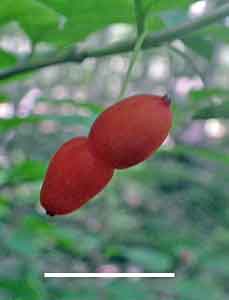Caprifoliaceae: Lonicera canadensis W.Bartram ex Marshall
(American fly-honeysuckle)
There are four honeysuckles (Lonicera spp.) in Nova Scotia including two native species (L. canadensis and mountain fly-honeysuckle, L. villosa) and two that are escapes from gardens (woodbine, L. periclymemum; Tatarian honeysuckle, L. tatarica). Both of the native species are shrubs 1-2 m in height with opposite leaves.
Leaves of L. canadensis are light green and widest below the middle (leaves of L. villosa are dark green and widest at or above the middle). L. canadensis has paired, bisexual flowers with distinctly separate ovaries, and nearly separate red fruits (versus united ovaries and united blush fruits in L. villosa). L. canadensis flowers in early May in Nova Scotia (L. villosa in May/early June). L. canadensis is common in mixed and deciduous forests in Nova Scotia (L. villosa occurs in bogs, wet pastures, heath-barrens, boggy thickets, and low pastures). L. canadensis has an eastern North American distribution, occurring in all provinces from Manitoba east except Newfoundland, and south to North Carolina. It has a secure status (S5) in Nova Scotia, but is critically imperiled (S1) in three states and in Manitoba.
Sources | Selected Web Resources| Line Drawing
Click on images for larger versions.
May 12, 2011. Halifax County: Halifax - oak woods at south end of Beaufort Avenue
Photographer: JackPine.
|

|  |
Jun. 12, 2011 Halifax County: Halifax - oak woods at south end of Beaufort Avenue
Photographer: JackPine.
|

|
|
July 2, 2011. Halifax County: Halifax - oak woods at south end of Beaufort Avenue
Photographer: JackPine.
|

|
 |
Selected Web Resources
- Taxonomic Status (ITIS)
Copy the species name above and paste it into a form on this ITIS Canada page to confirm the nomenclature and list synonyms.
- NatureServe Explorer Copy the species name above and paste it into a form on this page to view a map of its distribution within North America and its conservation status by province and state.









